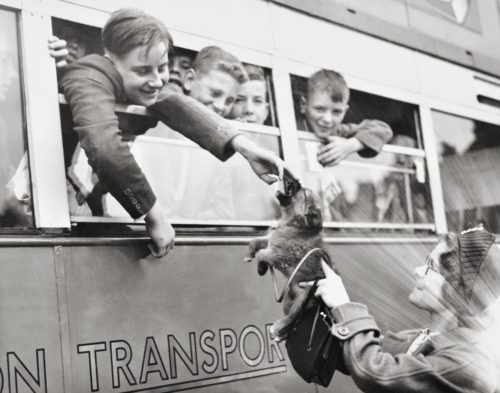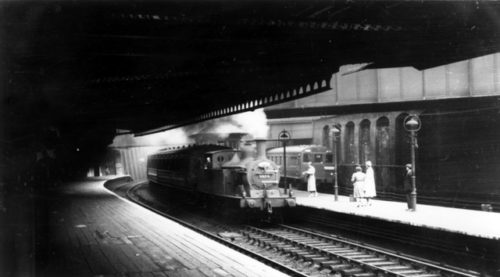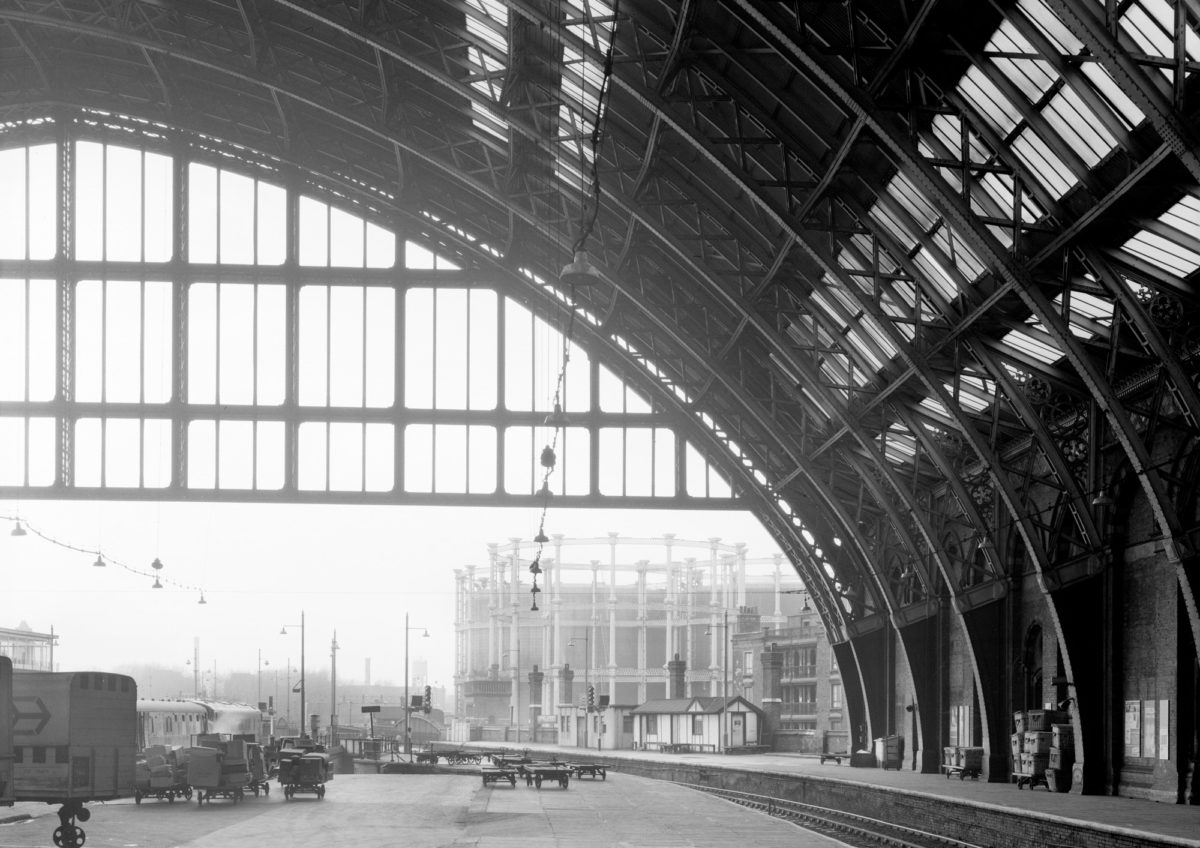In 1852 King’s Cross Station opened as the terminus of the Great Northern Railway with routes to the North East of England and Scotland. George Turnbull – dubbed “the first railway engineer of India” – developed plans, and the architect Lewis Cubitt drew up the final designs. Initially the two huge arched train sheds housed one arrival and one departure platform, but the station expanded as suburban train traffic grew, until by 1880 half of King’s Cross traffic travelled local routes. Grain, potatoes, cows, pigs, fish, cattle and coal were all transported, stored and distributed through King’s Cross.
In WWI – when the railways were nationalized and all rail, rolling stock and staff were managed centrally – high explosives were conveyed through the station and secreted in tunnels to protect them from enemy aircraft. After the war, in 1921 The Railways Act reorganized all 130 railway companies into four regional groups giving them a regional monopoly and setting out standard fares. One of these – London and North Eastern (LNER) – took ownership of King’s Cross.
During WWII large numbers of troops were safely transported via King’s Cross, but the station’s luck ran out in May 1941 when a bomb destroyed the general offices, booking hall and bar. Jean Hart, born in the East End was evacuated from King’s Cross during the Blitz and recalls her angst waiting to be claimed by a family, her first taste of country life and the exceptional leadership of her teenage teachers. Through WWII the government again took over the railways and, following the Labour win in 1945, the railways were nationalized under the 1947 Transport Act. During the 1950s and early 1960s diesel services overtook steam, and by the early 1970s electrification of suburban routes was underway. By 1977 electric services were running from King’s Cross to Hertford, Welwyn Garden City and Royston. In 1972 an extension containing the main passenger concourse and ticket office was built at the front of King’s Cross. On October 10th 1973 a youth threw a bag into the booking hall where it exploded – shattering glass, throwing a baggage trolley several feet in the air and injuring five people. The IRA claimed responsibility.

The 1996 privatisation of British Rail brought the King’s Cross express services into the hands of the Great North Eastern Railway (GNER) and after Chris Nettleton tells of his childhood exploits train-spotting in the 1950s he gives us a quick history of the end of steam era and the development of the British railways since the 1930s. As Editor of The Gresley Observer he also highlights the legacy of Nigel Gresley – designer of the Flying Scotsman (the first passenger train to record over 100 mph) and the Mallard (whose record of 126 mph still stands). For an insight into the Underground during the 60s and 70s we hear from Brian Hardy, whose childhood passion for the Underground evolved into a 39-year career working on it. He reflects on the changing culture, and the cancellations and staff losses on the Underground of the 60s and 70s.

In the station environs in the 1970s Don Hibbs worked as Food & Beverage manager in a hotel and recalls catering for Union meetings, the ladies of the night being fined 12/6 at the magistrates court, and strange goings on in the railway toilets.
In 2005, Network Rail’s plans for a £500 million restoration were approved and with the vision of John McAslan & partners the station was transformed. The green roof at the front of King’s Cross was removed to create a plaza to house outdoor markets and places to sit. Andy Savage Executive Director of the Railways Heritage Trust tells us about their work at King’s Cross, and the careful placing of the War Memorial during the redevelopment of the station.
Fred Garner, Director of Rail at Taylor Woodrow, came to King’s Cross in 2001 to upgrade the Underground and implement the Fennel Report in the wake of the 1987 fire. He returned to develop the main station ahead of the London Olympics in 2012. He tells of the phenomenon of Harry Potter – filmed during the station’s refurbishment – and of arriving at work alongside an owl in a cage. The station remained open throughout renovations, although the location of the Harry Potter luggage trolley was moved six times. Acclaimed architect Hiro Aso, on the celebrated John McAslan team transforming King’s Cross for 2012, tells how the original Victorian facades were preserved and a modern white diagrid roof built to span the new concourse – triple the size of the old one. This improved passenger capacity and made the station a destination in its own right with shops, cafés, boutiques and the biggest railway pub in the country. The success of the project has made it a blueprint for other leading stations worldwide.
Jon Burden – Duty Station Manager on King’s Cross Station from 2000 spotlights the attention to detail required for a smooth running station. He shares his experiences of IRA bomb-scares, the fallout from the Hatfield rail crash in October 2000, the Potters Bar crash of 2002 and the traumatic events of 7/7.
A current day commuter – Richard Gameson, Professor at Durham University in the history of the book from Antiquity to the Renaissance – speaks of his daylong commute to the British Library in order to study original documents. He makes the case that the internet is no match for the chance to feel manuscripts with his own hands.
Many Londoners recall the trauma of the 1987 King’s Cross fire, when a dropped match on the escalator between the Piccadilly line and the main line station caused an enormous fireball which tore up the escalator and took the lives of 31 people. Matt Lunn, born three years later in 1990, discovers the enormous impact the Fennel report still has on current day operations and safety protocols when he joins the Transport for London graduate scheme in 2015.

Sixty-seven acres around King’s Cross is still being developed with glamorous new homes, shopping arcades, offices and public spaces. With its close proximity to St Pancras’s regional services – and Eurostar link to Europe, Thameslink services and the London underground – King’s Cross is busy as well as beautiful.

Story by Sarah Monk
23 November 2018
